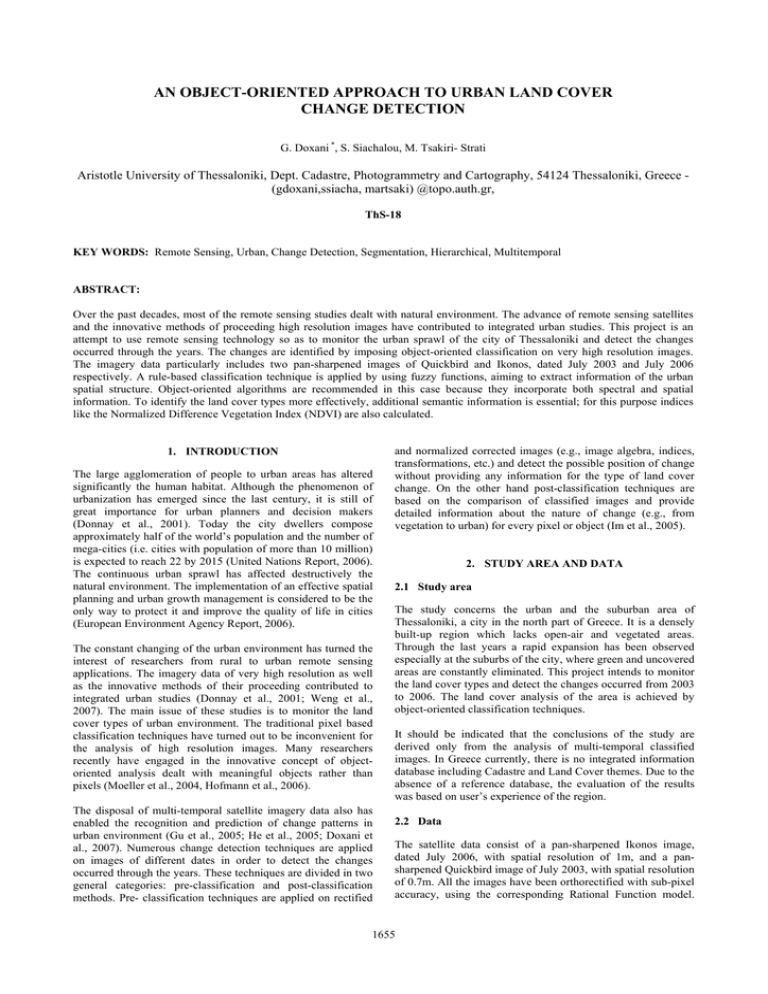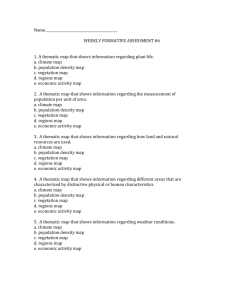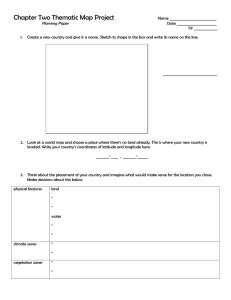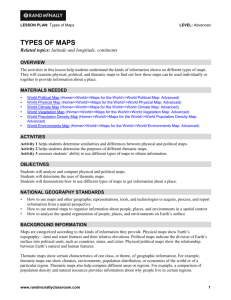AN OBJECT-ORIENTED APPROACH TO URBAN LAND COVER CHANGE DETECTION
advertisement

AN OBJECT-ORIENTED APPROACH TO URBAN LAND COVER CHANGE DETECTION G. Doxani *, S. Siachalou, M. Tsakiri- Strati Aristotle University of Thessaloniki, Dept. Cadastre, Photogrammetry and Cartography, 54124 Thessaloniki, Greece (gdoxani,ssiacha, martsaki) @topo.auth.gr, ThS-18 KEY WORDS: Remote Sensing, Urban, Change Detection, Segmentation, Hierarchical, Multitemporal ABSTRACT: Over the past decades, most of the remote sensing studies dealt with natural environment. The advance of remote sensing satellites and the innovative methods of proceeding high resolution images have contributed to integrated urban studies. This project is an attempt to use remote sensing technology so as to monitor the urban sprawl of the city of Thessaloniki and detect the changes occurred through the years. The changes are identified by imposing object-oriented classification on very high resolution images. The imagery data particularly includes two pan-sharpened images of Quickbird and Ikonos, dated July 2003 and July 2006 respectively. A rule-based classification technique is applied by using fuzzy functions, aiming to extract information of the urban spatial structure. Object-oriented algorithms are recommended in this case because they incorporate both spectral and spatial information. To identify the land cover types more effectively, additional semantic information is essential; for this purpose indices like the Normalized Difference Vegetation Index (NDVI) are also calculated. 1. INTRODUCTION The large agglomeration of people to urban areas has altered significantly the human habitat. Although the phenomenon of urbanization has emerged since the last century, it is still of great importance for urban planners and decision makers (Donnay et al., 2001). Today the city dwellers compose approximately half of the world’s population and the number of mega-cities (i.e. cities with population of more than 10 million) is expected to reach 22 by 2015 (United Nations Report, 2006). The continuous urban sprawl has affected destructively the natural environment. The implementation of an effective spatial planning and urban growth management is considered to be the only way to protect it and improve the quality of life in cities (European Environment Agency Report, 2006). The constant changing of the urban environment has turned the interest of researchers from rural to urban remote sensing applications. The imagery data of very high resolution as well as the innovative methods of their proceeding contributed to integrated urban studies (Donnay et al., 2001; Weng et al., 2007). The main issue of these studies is to monitor the land cover types of urban environment. The traditional pixel based classification techniques have turned out to be inconvenient for the analysis of high resolution images. Many researchers recently have engaged in the innovative concept of objectoriented analysis dealt with meaningful objects rather than pixels (Moeller et al., 2004, Hofmann et al., 2006). The disposal of multi-temporal satellite imagery data also has enabled the recognition and prediction of change patterns in urban environment (Gu et al., 2005; He et al., 2005; Doxani et al., 2007). Numerous change detection techniques are applied on images of different dates in order to detect the changes occurred through the years. These techniques are divided in two general categories: pre-classification and post-classification methods. Pre- classification techniques are applied on rectified and normalized corrected images (e.g., image algebra, indices, transformations, etc.) and detect the possible position of change without providing any information for the type of land cover change. On the other hand post-classification techniques are based on the comparison of classified images and provide detailed information about the nature of change (e.g., from vegetation to urban) for every pixel or object (Im et al., 2005). 2. STUDY AREA AND DATA 2.1 Study area The study concerns the urban and the suburban area of Thessaloniki, a city in the north part of Greece. It is a densely built-up region which lacks open-air and vegetated areas. Through the last years a rapid expansion has been observed especially at the suburbs of the city, where green and uncovered areas are constantly eliminated. This project intends to monitor the land cover types and detect the changes occurred from 2003 to 2006. The land cover analysis of the area is achieved by object-oriented classification techniques. It should be indicated that the conclusions of the study are derived only from the analysis of multi-temporal classified images. In Greece currently, there is no integrated information database including Cadastre and Land Cover themes. Due to the absence of a reference database, the evaluation of the results was based on user’s experience of the region. 2.2 Data The satellite data consist of a pan-sharpened Ikonos image, dated July 2006, with spatial resolution of 1m, and a pansharpened Quickbird image of July 2003, with spatial resolution of 0.7m. All the images have been orthorectified with sub-pixel accuracy, using the corresponding Rational Function model. 1655 The International Archives of the Photogrammetry, Remote Sensing and Spatial Information Sciences. Vol. XXXVII. Part B7. Beijing 2008 The degradation of Quickbird image from 0.7 to 1 m was essential for the effective comparison of the two images. The software used to realize all the above procedures was Erdas Imagine 9.0. 3. METHODOLOGY 3.1 Classification The object-oriented classification is the latest trend in image analysis. The traditional pixel-based methods are considered inadequate for a thorough urban land use classification (Zhan 2003; Siachalou et al., 2006; Navulur, 2007). The main advantage of object-oriented image processing is that it groups neighboring pixels into meaningful areas according to their spatial and spectral homogeneity. The formed meaningful objects are closer to the human perception of landscape than single pixels. Moreover the scale, the location and the neighborhood facilitate the land cover analysis of the complex urban environment. What is more interesting is that the object oriented approach takes into account not only the spectral information but also the form, the texture, the shape and an additional great variety of features based on image objects (Baatz et al., 2003). The fuzzy analysis of image objects is an additional advantage of object-oriented classification. A set of expressions, which can be membership functions, similarities to classes or a nearest neighbor, is used for the effective combination of the object features and the integrated class definition. Then every object obtains a certain membership degree to a specific class, according to the degree of agreement with the class description. The fuzzy approach of classification can handle the vagueness and the mixture of classes of urban land cover heterogeneity (Baatz et al., 2003). The change detection process followed in this paper aims to detect the changes of the same urban landscape by classifying two images of different dates. The segmentation of the recent dataset is based on the spatial structure of the first one (base image), so as to achieve an effective comparison of classified objects. The changes are identified in a new level by setting the appropriate expressions and thresholds to the classes of the initial levels. 3.2 Data pre-processing The spectral variability of very high resolution images increases the noise within land use classes. Therefore there is a need for supplementary information for the exact description of the classes. In particular the normalised difference vegetation index (NDVI) was calculated at first so as to highlight the vegetated areas. By combining visible and infrared satellite bands, NDVI is considered to be more sensitive to low levels of vegetative cover (Navulur, 2007). The analysis of the images to Principal Components (PCA) was the following step of the procedure. PCA transformation is often used as a method of data compression. The “compression” here is referred to the reduction of the dimensions of a dataset without losing the characteristics that contribute most to its variance. As the bands of PCA data are not correlated, they are often more interpretable than the source data (Smith, 2002). In this project the information of the first three components was essential for the determination of land cover classes. PC2 was a useful layer for the detection of the impervious areas and PC3 for soil and tiled roofs. Apart from using them as independent bands, they were combined with the initial ones for the estimation of shadow indicator. The Shadow General Indicator was defined as the difference of brightness values between the Blue band and PC1 (Nobrega et al., 2006). The objects that correspond to shadow have low brightness values in both bands, so the difference was expected to be even lower or negative. ShadowGeneralIndicator = Blueband - PC1 where (1) Blueband = mean value of Blue band PC1= mean value of PC1 3.3 Classification of the base image The Quickbird image dated 2003 and its corresponding NDVI and PCA images were considered as the base image dataset. The eight available image layers (4 initial bands, NDVI, PC1, PC2, PC3) were segmented into meaningful objects. The scale parameter 20 was selected in order to detect even the sparse urban vegetation. The hierarchical structure of the classification scheme allowed the semantic organization of the classes and reduced their complexity. The vegetated and no-vegetated areas were initially detected. These general classes were considered to be “parent” classes in the class hierarchy. The “parent” classes were then separated into “child” classes and passed them their descriptions. The workflow of the project is presented in figure 1. The class “vegetated areas” was divided into the classes “dense vegetation” and “sparse vegetation”. The feature “mean value of NDVI layer” was used for the definition of the classes. “No vegetated areas” were then classified as “shadow”, “soil like areas” and “impervious areas”. The description of class “shadow” was based on the customized feature of shadow indicator (Equation1). The “soil like areas” included both bare soil areas and tiled roofs. The separation of these two classes was a complicated task because of their overlapping spectral signatures. Therefore the class “soil like areas” was selected as the parent class and the corresponding objects were detected by the feature “mean value of PC 3 layer”. In order to describe the class “tiled roofs” the shape feature “Rectangular Fit” was chosen, due to their form. The remaining objects were classified as “impervious areas”. For the precise separation of the classes different membership functions and thresholds were set to the chosen features. Figure 1. The class hierarchy for the classification of both images 1656 The International Archives of the Photogrammetry, Remote Sensing and Spatial Information Sciences. Vol. XXXVII. Part B7. Beijing 2008 thematic layer was set to 1. The image segmentation depended only on the thematic layer (by weighting all image layers with 0). The information of the thematic layer was essential at this point because it prevented the creation of objects that exceed the borders of thematic polygons or are larger than the polygons (Figure 4). Therefore the objects of the two classified images had the same spatial borders and the changed objects were more accurately identified. The division of the new sub-level is presented in Figure 5. In this way changes between the thematic layer information and the current image object level are extracted as separate image objects. The class hierarchy was built in that way so as to handle properly the “changed” objects (Figure 6). First of all land cover thematic layer should be recreated in this new sub-level. The thematic attribute “Color” was used so as to assign every object to a class of thematic layer. The attribute was specified by a unique number (color_id) of thematic database available for every color. In this way the display of the base classification was achieved. The result so far was two levels, the one referred to the classification of 2006 (Level_2006) and the other (sublevel) to the classification of 2003 (Level_changes). Figure 2. The classification of Quickbird image of 2003 The object-oriented classification approach allows the user to handle the classification results as polygons (objects). Hence the classification results of image dated 2003 are exported as shape file so as to be used as a thematic layer (supplementary information) for the classification of the image of 2006. Classified image 2006 Thematic layer 2003 3.4 Change detection Vegetation The most recent available image dataset was dated on 2006 and it comprised of the four bands of Ikonos pan-sharpened, and the corresponding NDVI, PC1, PC2 and PC3 images. The classified image of 2003 was also imported as a thematic layer. The classes were the same with the ones of the thematic layer and the class hierarchy followed the logical scheme of the previous classification. Therefore there was no need to redesign the class hierarchy. The only essential task was to redefine the thresholds for some features. The result of the procedure was the classification of the scene land cover types of 2006 (Figure3). Change No change No vegetation Vegetation Figure 4. The detection of changed sub-objects No vegetation Vegetation No vegetation No vegetation No change Change Thematic layer 2003 Vegetation Classified image 2006 No change Change detection Sub level Figure 5. The detection of changed objects The hierarchical structure allows the objects’ analysis through different segmentation levels. Therefore the thematic classes were considered as the “parent classes” and passed down their descriptions to “child classes”. The feature “Existence of super Objects” was used for the detection of objects that did not change class. The inverted expression of the feature “Similarity to a class” was used to define the changed objects. For example the objects that did not change class were classified as “bare soil_2006” and the rest as “changes_bare soil”. Figure 3. The classification of Ikonos image of 2006 The detection of changed objects was accomplished in a new sub-level. During the segmentation process the weight for the 1657 The International Archives of the Photogrammetry, Remote Sensing and Spatial Information Sciences. Vol. XXXVII. Part B7. Beijing 2008 4.2 Analysis of change detection results In order to quantify the change detection results, the area of the objects classified as “changes” was calculated. The feature “Area of classified objects” was used to automatically estimate the area of these objects (Table 2). What is more interesting is to identify the nature of change (from-to). The hierarchical structure gives the possibility to handle the objects of different segmentation levels. In this project there was a level with the thematic layer (classified image of 2003) and a super level with the classified image of 2006. The set of features “Relations to sub objects” and specifically the feature “Area of” allowed the automatic determination of the area of the sub-objects. The classified objects of 2006 were then exported as shape polygons. The area of sub objects of every class was included in the corresponding thematic database. Table 3 includes the percentage of subobjects’ area. Figure 6. The class hierarchy for change detection Changes from 2003 to 2006 (m2) 8413 22853 2540 10522 20865 Classes Impervious surface Bare soil Tiled roofs Dense vegetation Sparse vegetation (%) 6,54 17,75 1,97 8,17 16,21 Table 2. Changes from 2003 to 2006 for each class respectively Tiled roofs Dense vegetation Sparse vegetation Impervious surface Figure 7. The detected changes (purple colour) between the years 2003 and 2006 Bare soil 2003 Bare soil 0,32 0,16 0,09 0,42 0,15 Tiled roofs 3,48 3,64 0,57 1,99 2,58 0,18 0,02 4,37 1,71 0,68 2,92 0,48 3,48 10,32 3,13 10,8 4 1,32 4,02 12,09 31,02 Classes 4. RESULTS The evaluation of the classification results was carried out using the original satellite images. As mentioned, there was no any available information including Cadastre and Land Cover themes. The evaluation was accomplished by using 20 samples (objects) per each class, which were distributed randomly on the original images. The overall accuracy and kappa statistics for both classified images were considered satisfactory (Table 1), given that the lowest value of overall accuracy and Kappa coefficient should have been 70-75% and 65% respectively. Despite the acceptable results, a more rigorous assessment is required to evaluate the classification products more accurate. Accuracy Statistics Overall Accuracy (OA) Overall Kappa Statistics Classification of image dated 2003 Classification of image dated 2006 87,6 % 84,88 % 0,856 0,847 2006 4.1 Classification accuracy assessment Dense vegetation Sparse vegetation Impervious surface Table 3. The from-to changes (%) between 2003 and 2006 for each class respectively The results indicated that the classes “bare soil” and “sparse vegetation” experienced the most significant changes. Particularly the 22.93% of impervious surface area in 2006 derived from bare soil and sparse vegetated areas, a fact that verified the elimination of open air areas. The area per cent of changes from “impervious surface” to “sparse vegetation” has a relatively high value. Probably a mixture of vegetation and residential objects led to a misclassification of the corresponding objects. In addition the great values of the Table 1. Accuracy results for both classified images 1658 The International Archives of the Photogrammetry, Remote Sensing and Spatial Information Sciences. Vol. XXXVII. Part B7. Beijing 2008 changes from “bare soil” and “dense vegetation” to “sparse vegetation” were attributed to different phenological circle characteristics, despite the fact that the images were acquired at the same month. 14 Bare soil Changes (%) 12 Errors. Photogrammetric Engineering & Remote Sensing, 73(4), pp. 375-383. Walker, J., Briggs J., 2007. An Object-oriented Approach to Urban Forest Mapping in Phoenix. Photogrammetric Engineering & Remote Sensing, 73(5), pp. 577-583. Tiled roofs 10 Dense vegetation Sparse vegetation 8 Impervious surface References from Books: Baatz M, Benz U, Dehghani S, Heynen M, Holtje A, Hofmann P, Lingenfelder I, Mimler M, Sohlbach M, Weber M & Willhauck G, 2003. eCognition User Guide3, pp.1.4-1.8, 3.173.22, 3.35-3.40 6 4 Donnay, J. P., Barnsley, M., Longley, P., 2001. Remote Sensing and Urban Analysis. Taylor & Francis, Great Britain, pp.145-159, 245-258. 2 0 Bare soil Tiled roofs Dense vegetation Sparse vegetation Impervious surface Jensen, R.J., 2005. Introductory Digital Image Processing. Pearson Education, USA, pp.393-394, 467-471. Classes Figure 8. The diagram of from-to changes (%) between 2003 and 2006 for each class respectively 5. CONCLUSION The aim of this project was to demonstrate the object oriented analysis of multitemporal images for an effective change detection. The hierarchical structure of objects and the available number of features allowed the accurate classification of the very high resolution image data. There are numerous ways and methods to handle objects for the efficient identification of changes. In this project the classified image of the first date was chosen as the base image and exported as a thematic layer. This procedure was chosen in order to create a land cover database and exploit the results in future applications. The classification as well as the change detection scheme can be applied on any other image of the region for semi-automatic change detection. Moreover with the advantage of determining the exact “from-to” change, a GIS post classification process can be omitted. The study was regarded as an intriguing approach to monitor land cover changes of an area with no any previous spatial record. The results confirmed the expanding tension of the city of Thessaloniki, as illustrated by the elimination of the open air areas and their transformation to built-up areas (impervious). The analysis, the structure, the classification and generally all the information related to the objects can be organized and managed in a GIS database. In this way urban growth prediction and land use studies can be accomplished effectively. REFERENCES References from Journals: Im, J., Jensen, J.R., 2005. A change detection model based on neighborhood correlation image analysis and decision tree classification. Remote Sensing of Environment 99,pp. 326 – 340 Sundaresan, A., Varshney, P., Arora, M., 2007. Robustness of Change Detection Algorithms in the Presence of Registration Navulur, K., 2007. Multispectral Image Analysis Using the Object-Oriented Paradigm. Taylor & Francis Group, USA, pp.15-18,120-121. Weng, Q., Quattrochi D., 2007. Urban Remote Sensing. Taylor & Francis Group, USA, Introduction. References from Other Literature: Baatz, M., Benz, U., Dehghani, S., Heynen, M., Holtje, A., Hofmann, P., Lingenfelder, I., Mimler, M., Sohlbach, M., Weber, M., Willhauck, G., 2003. eCognition User Guide3, Definiens Imaging, pp.3.35-3.53. Doxani, G., Siachalou, S., Tsakiri-Strati, M., 2007. Detecting urban land cover changes based on high resolution multitemporal images: a case study for Thessaloniki Metropolitan area. In: Proceedings of 7th Geomatic Week Conference, Barcelona Gu, J., Chen, J., Zhou, Q., 2005. A Hierarchical ObjectOriented Approach for Extracting Residential Areas from High Resolution Imagery. In: Proceedings of IPSRS Hannover Workshop: High Resolution Earth Imaging for Geospatial Information, Hannover. He, C., Li, J., Zhang, J., Pan, Y., Chen, Y., 2005. Dynamic monitor on urban expansion based on a object-oriented approach. In: Geoscience and Remote Sensing Symposium, 2005. IGARSS '05. Proceedings. 2005 IEEE International, 4, Issue 25-29, July 2005, pp. 2850-2853 Hofmann, P., Strobl, J., Blaschke, T., Kux, H., 2006. Detecting Informal Settlements from Quickbird Data in Rio de Janeiro using an object based approach. In: 1st International Conference on Object-based Image Analysis (OBIA 2006), Salzburg University, Austria. Hong, G., Zhang, Y., 2005. Radiometric Normalization of Ikonos image using Quickbird image for urban area change detection. In: Proceedings of the ISPRS joint conference 3rd International Symposium Remote Sensing and Data Fusion Over Urban Areas (URBAN 2005) - 5th International Symposium Remote Sensing of Urban Areas (URS 2005), Tempe, AZ, USA. Kux, H., Araújo, E., 2006. Multi-temporal Object-Oriented Classifications and Analysis of Quickbird scenes at a 1659 The International Archives of the Photogrammetry, Remote Sensing and Spatial Information Sciences. Vol. XXXVII. Part B7. Beijing 2008 metropolitan area in Brazil (Belo Horizonte, Minas Gerais State). In: Proceedings of the 1st International Conference on Object-based Image Analysis (OBIA 2006), Salzburg University, Austria. Möller, M., Stefanov, W., Netzband, M., 2004. Characterizing landcover changes in a rapidly growing metropolitan area using long term satellite imagery. In: Proceedings of the 2004 Annual Meeting of the American Society for Photogrammetry and Remote Sensing, Denver, CO. Nobrega R.A.A., O'hara C.G., Quintanilha J.A., 2006. Detecting roads in informal settlements surrounding Sao Paulo City by using object-based classification. In: 1st International Conference on Object-based Image Analysis (OBIA 2006), Salzburg University, Austria. Siachalou, S., Doxani, G, Tsakiri- Strati, M., 2006. ObjectOriented Analysis of High Resolution Imagery for Urban Data Management. In: Proceedings of 25th Urban Data Management Symposium, Aalborg. Zhan Q., 2003. A hierarchical Object-based approach for urban land-use classification from remote sensing data. PhD Dissertation in ITC References from websites: United Nations, 2006. Department of Economic and Social Affairs, Population Division “World Urbanization Prospects”: The 2005 Revision. Working Paper No.ESA/P/WP/200. http://www.un.org/esa/population/publications/WUP2005/2005 WUP_FS7.pdf (accessed 17 Oct. 2007) European Environment Agency Report, 2006. “Urban sprawl in Europe” The ignored challenge No 10/2006, pp. 5-6, 28-35. http://reports.eea.europa.eu/eea_report_2006_10/en (accessed 17 Oct. 2007) Smith, L. I., 2002. A tutorial on Principal Components Analysis. http://www.cs.otago.ac.nz/cosc453/student_tutorials/principal_c omponents.pdf Steinnocher, K., Kressler F., 2006. In: Final Report of European Spatial Data Research (EuroSDR) Projects - Commission 2 “Image analysis and information content” - Change Detection. http://www.eurosdr.net/publications/50.pdf (accessed 19 Oct. 2007) 1660








